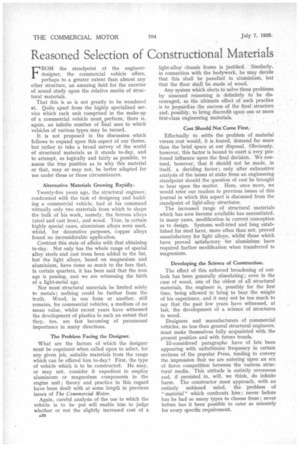Reasoned Selection of Constructional Materials
Page 32

If you've noticed an error in this article please click here to report it so we can fix it.
FROM the standpoint of the engineerdesigner, the commercial vehicle offers, perhaps to a greater extent than almost any other structure, an amazing field for the exercise of sound study upon the relative merits of structural materials.
That this is so is not greatly to be wondered at. Quite apart from the highly specialized service which each unit comprised in the make-up of a commercial vehicle must perform, there is, again, an infinite number of Rnal uses to which vehicles of various types may be turned.
It is not proposed in the discussion which follows to expand upon this aspect of our theme, but rather to take a broad survey of the world of structural materials as it stands to-day, and to attempt, as logically and fairly as possible, to assess the true position as to why this material or that, may or may not, be better adapted for use under these or those circumstances.
Alternative Materials Growing Rapidly.
Twenty-five years ago, the structural engineer, confronted with the task of designing and building a commercial vehicle, had at his command virtually only two materials from which to shape the bulk of his work, namely, the ferrous alloys (steel and cast iron), and wood. True, in certain highly special cases, aluminium alloys were used, whilst, for decorative purposes, copper alloys found no inconsiderable application.
Contrast this state of affairs with that obtaining to-day. Not only has the whole range of special alloy steels and cast irons been added to the list, but the light alloys, based on magnesium and aluminium, have come so much to the fore that, in certain quarters, it has been said that the iron age is passing, and we are witnessing the birth of a light-metal age.
Nor must structural materials be limited solely to metals ; nothing could be further from the truth. Wood, in one form or another, still remains, for commercial vehicles, a medium of no mean value, whilst recent years have witnessed the development of plastics to such an extent that they, too, are fast becoming of paramount importance in many directions.
The Problem Facing the Designer.
What are the factors of which the designer must be cognizant when called upon to select, for any given job, suitable materials from the range which can be offered him to-day? First, the type of vehicle which is to be constructed. He may, or may not, consider it expedient to employ aluminium or magnesium components in the engine unit ; theory and practice in this regard have been dealt with at some length in previous issues of The Commercial Motor.
Again, careful analysis of the use to which the vehicle is to be put will enable him to judge whether or not the slightly increased cost of a light-alloy chassis frame is justified. Similarly, in connection with the bodywork, he may decide that this shall be panelled in aluminium, but that the floor shall be made of wood.
Any system which elects to solve these problems by unsound reasoning is definitely to be discouraged, as the ultimate effect of such practice is to jeopardize the success of the final structure and, possibly, to bring discredit upon one or more first-class engineering materials.
Cost Should Not Come First.
Effectually to settle the problem of material versus cost would, it is feared, demand far more than the brief space at our disposal. Obviously, however, this factor is bound to exert a very profound influence upon the final decision. We contend, however, that it should not be made, in itself, a deciding factor ; only after exhaustive analysis of the issues at stake from an engineering standpoint should the question of cost be brought to bear upon the matter. Here, once more, we would refer our readers to previous issues of this journal in which this aspect is discussed from the standpoint of light-alloy structures.
The increased range of structural materials which has now become available has necessitated, in many cases, modification in current conception as to design. Systems well-tried and long established for steel have, more often than not, proved unsatisfactory for light alloys, whilst those which have proved satisfactory for aluminium have required further modification when transferred to magnesium.
Developing the Science of Construction.
The effect of this enforced broadening of outlook has been generally stimulating ; even in the case of wood, one of the oldest of all structural materials, the engineer is, possibly for the first time, being allowed to bring to bear the weight of his experience, and it may not be too much to say that the past few years have witnessed, at last, the development of a science of structures in wood.
Designers and manufacturers of commercial vehicles, no less than general structural engineers, must make themselves fully acquainted with the present position and with future trends.
Ill-considered paragraphs have of late been appearing with unfortunate frequency in certain sections of the popular Press, tending to convey the impression that we are entering upon an era of fierce competition between the various structural media. This attitude is entirely erroneous and, if persisted in, will, we think, do infinite harm. The constructor must approach, with an entirely unbiased mind, the problem of "material" which confronts him ; never before has he had so many types to choose from ; never before has it been possible to cater so minutely for every specific requirement.




















































































